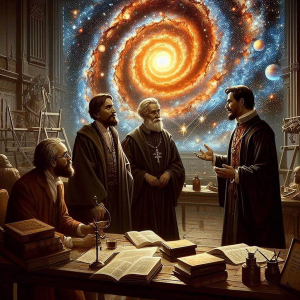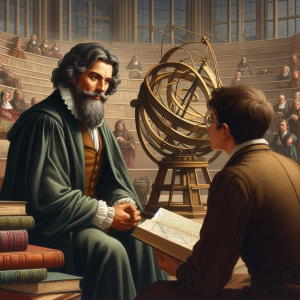
(Previous)…..(Content)…..(Next)
The foundation of “Proto SF-F”
The Years of the “Enlightenment”, the “Age of Reason”, and the “evolutions” of SF-F up to 1800
(Romanian)

In the previous episode (3), one could conclude that “we could have moved on”, but we would have skipped many necessary “steps” of “Science Fiction” (or, at least, some significant details) in what would be the “foundation of proto science fiction.”
A period of development that many “academic” opinions call “Proto-science fiction in the Enlightenment and the Age of Reason” …
A period that will continue, with the status of “Proto Science Fiction” until the end of the 1930s of the 20th century… A period that will “end”, forced by “academic” statements, in what was called the “Golden Age” … Which “Golden Age”, according to the arguments that you will discover throughout this work, would “start” only starting with the year 2000…
“Zone” of time in which “Science Fiction” (or even the SF-F “zone”) knows the full affirmation of the propagation media, represented by the common manifestation of the “written word” (the novel and its subdivision species), film (cinematography and compatible manifestations, including television series with a “Science Fiction” specificity and associated subgenres) and video games (the interactive image cumulated through the “written word”)…
But let’s proceed to the “step-by-step argument” … Through a chronological “completion” of the approaches…
The period of Enlightenment and the Age of Reason (the 18th century) represents a crucial moment in the evolution of human thought and, implicitly, in the emergence of what we can call “proto-science fiction”.
It is that “moment” (actually period) in which, according to the initial analogy of this “series” with the development of a human individual, when “Science Fiction” is during intrauterine development, and that moment comes between 4 — 4.5 months of pregnancy when, human embryos which are, without exception, morphologically mostly female (only the genes “know” what will come next), “proceed” to sexual delimitation (through individual development, in most cases, into male or female individuals)
Returning to this period, characterized by a strong emphasis on reason, logic, empirical observation, and progress, laid the intellectual foundations for the later development of modern science fiction at an early stage.
The main characteristics of “Proto-science fiction” in the Enlightenment and the Age of Reason are represented by:
1. Rationalization of Explanations: Unlike previous periods, the Enlightenment “initiated” and promoted the search for rational explanations for natural phenomena, to the detriment of mythological or religious explanations (with a significant impact in terms of an increasingly pronounced individualization between “Science Fiction” and “Fantasy”). A “parenthesis” emphasized by the reality that this trend was also reflected in fiction, where fantastic elements began to be replaced (or at least justified in a pseudo-scientific way) by ideas that sounded more “plausible” in the context of the knowledge of the era.
2. Fascination with Scientific Discoveries and Inventions: Advances in astronomy, physics, chemistry, and mechanics captivated the imagination of writers. In the “Age of Reason,” the “cosmic” rupture is achieved. Ideas such as Newton’s universal gravitation, discoveries about electricity, or the first attempts at flight inspired fictional speculations.
To understand the “contribution” of this “Age of Reason”, I will make a “parenthesis”.
During this period, Galileo Galilei and Johannes Kepler played a crucial role in promoting the heliocentric theory, providing strong observational and theoretical evidence that contradicted the Ptolemaic geocentric model, which had been dominant for over a millennium and associated with the cosmology of the time, including in the case of religious interpretations.
However, the “elimination” was not a simple or immediate process, nor achieved exclusively by Galileo and Kepler, being, in fact, a gradual shift in scientific paradigm, begun by Nicolaus Copernicus and continued by many others.

Furthermore, the acceptance of the heliocentric theory, especially by religious institutions, encountered considerable resistance, with the Catholic Church initially opposing this theory, considering it to be in contradiction with certain scriptural interpretations, the result being the reality that Galileo was condemned for supporting it (remember, to death by burning at the stake, considering his “fantasy” to be a “mortal sin”).
It is also important to emphasize that the Ptolemaic model, although integrated into a worldview that also included religious aspects, was not in itself a purely religious dogma, but a scientific model, albeit an erroneous one. The conflict arose when a new scientific model questioned the established understanding of the cosmos, with implications for theological interpretations (which, at that level, also had a massive social, political, cultural, etc. impact).
Furthermore, although the contributions of Galileo and Kepler profoundly influenced the intellectual climate of the Age of Reason, the peak of this period, with its emphasis on reason and empirical evidence, came later (similar behavior in the case of the evolution of “Science Fiction”).
In conclusion, Galileo and Kepler provided essential evidence that undermined the Ptolemaic geocentric model (being, in fact, a kind of initiatory act, considered or accused of being “Fantasy”, heretical, what is “right”). However, this was not a rapid or universally accepted “elimination”, nor directed exclusively against a “concept of religion”.
Noting to be just one complex scientific change in basic assumptions, with profound implications for understanding the universe and humanity’s place in it, leading to significant intellectual and cultural transformations during and after the Age of Reason.
A kind of development algorithm quite similar, as you will notice, to the evolution of “Science Fiction” …
3. Exploration of Ideal Societies and Social Criticism through Fiction: The reforming spirit of the Enlightenment led to a reevaluation of existing social and political structures. Times in which fiction became a tool for exploring ideal societies (rational utopias, based on Enlightenment principles) or for satirical criticism of existing institutions and customs (proto dystopias).
4. Imaginary Journeys to Faraway Places with an Exploratory Purpose: Travelogues (often fictional) were no longer exotic lands full of wonders, but also about the discovery of new forms of social organization, political systems, or even unusual life forms (albeit often with a fantastical component).
5. The Emergence of a Wider Reading Public and Prose Literary Forms: The rise of literacy and the popularity of the novel provided a fertile environment for the development of longer, more elaborate narratives that could explore complex ideas.
In a previous episode, we emphasized that the advent of printing allowed the propagation of the science of the times, a propagation that “extended” to fiction that noted the scientific errors of the moment and “propagated” ideas that would often “become” “unapproved scientific suggestions”…
Examples of “Proto Science Fiction” in the Enlightenment and the Age of Reason (although the label is retrospective) that can be quickly given:
- “Gulliver’s Travels” (1726) by Jonathan Swift: Although often classified as satire and fantasy, the work explores alternative societies with different rules and structures, offering a critique of English society from the perspective of reason. Travels to lands with small or giant people can be seen as explorations of relativity and extreme social differences.
- Utopian novels of the Enlightenment: There were various attempts to describe ideal societies based on rational principles, although many of them are less well known today. These often focused on education, justice, government, and science.
- Fictions about travel to the Moon or other planets (often with fantastic elements): As astronomy progressed, fictional speculations about life on other celestial bodies and ways to get there emerged, even if often mixed with fantastic or scientifically naive elements.
- Novels that explore the consequences of imaginary “scientific” discoveries: Although rarer, some works may have speculated on the effects of inventions or discoveries that did not exist, foreshadowing modern science fiction’s concerns about the impact of technology.
Now, obviously, it is obvious that it will be necessary to analyze some differences of the analyzed period compared to modern SF…
So, it is crucial to note that this “proto-science fiction” differs significantly from modern science fiction in:
- Lack of a rigorous scientific framework: Speculation was often based on the limited understanding of science at the time.
- Frequent presence of fantastic elements: The boundary between what we would call science fiction and fantasy today was still blurred.
- The main purpose was often satirical, philosophical, or political: The exploration of scientific or technological ideas was not always the central purpose.

In conclusion, the Enlightenment and the Age of Reason provided fertile ground for the germination of ideas that would form the basis of modern science fiction. The emphasis on reason, observation, progress, and social criticism, combined with a fascination with scientific discovery and the exploration of new worlds (whether geographical or social), created a context in which fictional speculation began to move away from purely mythological explanations and explore possibilities based on an understanding (albeit incipient) of the natural world and human potential. This period laid the foundation for a more “scientific” approach to speculative fiction in the following centuries.
Let’s also proceed to the “exemplary” elements found in various novels of those times (without forgetting that we also gave numerous examples in the previous episode regarding the period from the Middle Ages to the 1800s).
Following the scientific discoveries that characterized the Enlightenment, several new types of literature began to take shape in 16th-century Europe.
Humanist thinker Thomas More’s 1516 work of fiction and political philosophy, Utopia, describes a fictional island whose inhabitants have perfected every aspect of their society. The name of society stuck, giving rise to the utopia motif that would become so prevalent in later science fiction to describe a perfect world, but either unattainable or perversely flawed.
Then, why not, it would be “The Legend of Faust” (1587), which contains an early prototype for the story of the mad scientist…
In the 17th and 18th centuries, the so-called “Age of Reason” and widespread interest in scientific discovery fueled the creation of speculative fiction that anticipated many of what would become more recent science fiction tropes.
Several works expanded on imaginary journeys to the Moon, first in Johannes Kepler’s Somnium (The Dream, 1634), which both Carl Sagan and Isaac Asimov have called the first work of science fiction (in this novel Kepler describes an imaginary journey to the Moon, combining scientific descriptions and fantasy fiction, later influencing the science fiction genre).
Similarly, some identify Francis Godwin’s “The Man in the Moone” (1638) as the first work of science fiction in the English language, and Cyrano de Bergerac’s “The Comical History of the States and Empires of the World of the Moon” (1656).
Space travel also figures prominently in Voltaire’s Micromégas (1752), which is also notable for suggesting that people on other worlds might be in some ways more advanced than those on Earth (many scholars consider the novel to be one of the first clear examples of science fiction, Voltaire imagining an alien giant from Sirius visiting Earth). One might also recall Voltaire’s Candide (1759) …
Other works containing proto-science fiction elements from the Age of Reason of the 17th and 18th centuries include (in chronological order):
- Shakespeare’s The Tempest (1610–1611) contains a prototype for the “mad scientist tale”.
- The City of the Sun by Tommaso Campanella (1623).
- Francis Bacon’s New Atlantis (1627), an incomplete utopian novel.
- Christianopolis was written by Johann Valentin Andreae (1629).
- Margaret Cavendish, “The Description of a New World, (The Blazing-World)” (1666), a novel describing another world (with different stars in the sky) that can be reached via the North Pole.
- Discussion of the Plurality of Worlds by Bernard de Fontenelle (1686).
- Daniel Defoe’s “The Consolidator” (1705) revolves around a trip to the Moon.
- “Voyages et Aventures de Jacques Massé” (1710) by Simon Tyssot de Patot presents a lost world.
- “La Vie, Les Aventures et Le Voyage de Groenland du Révérend Père Cordelier Pierre de Mésange” (1720) by Simon Tyssot de Patot features an empty Earth.
- Samuel Madden’s “Memoirs of the Twentieth Century” (1733), in which a narrator in 1728 receives a series of state documents from 1997 to 1998 from his guardian angel, is a plot device reminiscent of later time-travel novels. However, the story does not explain how the angel obtained these documents.
- Ludvig Holberg’s “Underground Travels of Niels Klim” (1741) is an early example of the Hollow Earth genre.
- Journeys of Lord Seton in Seven Planets (Voyage de Milord Céton dans les Sept Planètes) by Marie-Anne de Roumier-Robert (1765).
- “L’An 2500” (1771) by Louis-Sébastien Mercier offers a predictive account of life in the 20th century.
- “La Découverte Australe par un Homme Volant” (1781) by Nicolas-Edmé Restif de la Bretonne presents prophetic inventions.
- Giacomo Casanova’s “Icosameron” (1788) is a novel that uses the hollow Earth device.
And the examples would be more numerous than you can imagine…
Yes, it would be a kind of comment worth remembering: “Notice the massive participation of European writers, what will be noted by the genius of that time, called Jules Verne?” (which will appear a little later, the “described” works being a kind of accumulation to feed the future “father” of “Science Fiction”) …

Finally, as a conclusion, we explored the literature of the Middle Ages and the pre-modern period through the prism of modern science fiction concepts, concluding that this period reveals a fascinating prehistory of the genre. From the distant lands and rudimentary automata of the Middle Ages to the first sketches of utopias and timid speculations about air travel, noting a slow but constant evolution of the human imagination in the direction of exploring “other worlds” and technological possibilities.
However, it was not until the intellectual effervescence of the Enlightenment and the Age of Reason that we witnessed a notable change. The emphasis on reason, observation, and progress provided a new framework for fictional speculation.
Although still laced with fantastical elements or with primarily satirical and philosophical purposes, works from this period began to explore alternative societies based on rational principles, to imagine the consequences of scientific discoveries (even if imaginary), and to use travel to distant places as tools of social and political exploration.
This crucial period set the stage for the emergence of modern science fiction, providing an essential intellectual and thematic foundation.
The fascination with scientific discoveries, the desire to build ideal societies (or to warn against undesirable ones), and the curiosity about the unknown were redefined under the light of reason, laying the foundation for the conscious exploration of the implications of science and technology on society and on man’s place in the universe, characteristic of the science fiction genre as we know it today.
Thus, the “proto-science fiction” of the Enlightenment is not just a historical curiosity, but a vital stage in the long and fascinating evolution of one of the most imaginative and relevant literary genres.
And our “evolution” will continue!
Merticaru Dorin Nicolae




